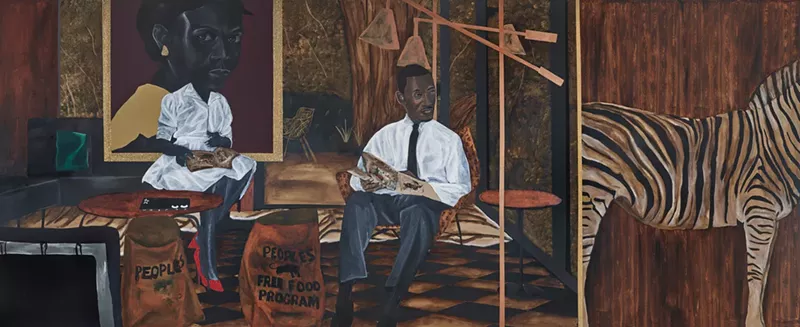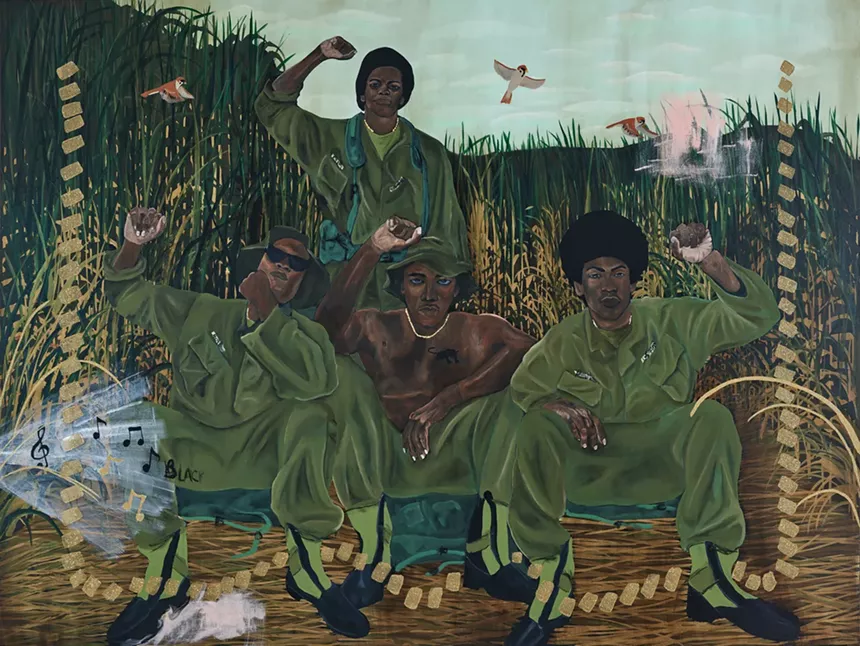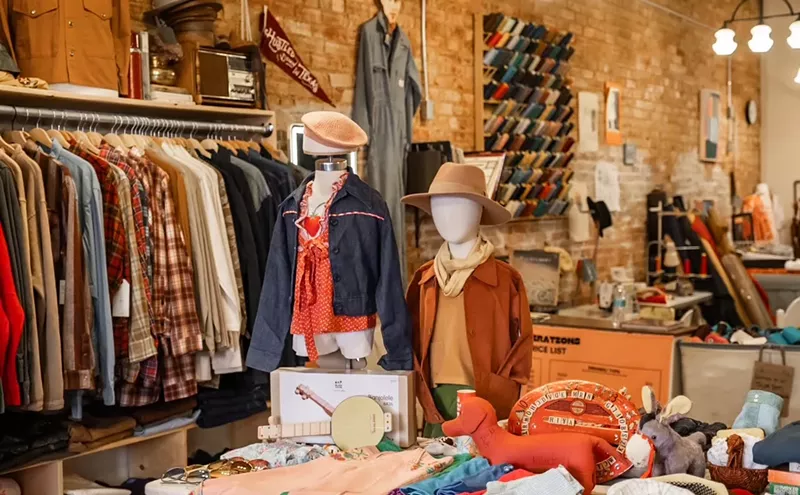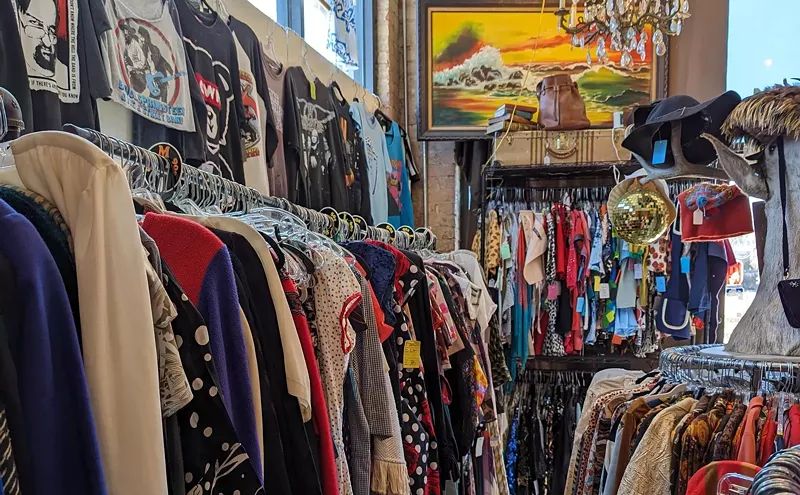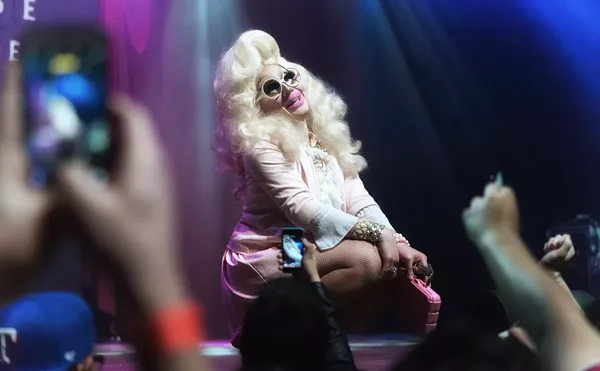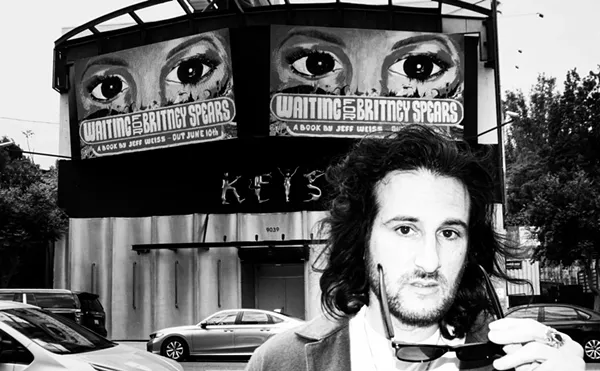In an age oversaturated with worthy causes and fragmented attention spans, how do artists engage with their audiences in the most impactful way? Make the revolution irresistible, naturally.
Jammie Holmes does just that in his current show at the Modern Art Museum of Fort Worth. The Thibodaux, Louisiana-born painter's large-scale works are casual and layered. Although they seemingly portray the most banal moments of life — a haircut, a baptism, a dinner party — there is symbolism afoot. Political totems nod to the Black Panther party, and sparrows signifying memento mori crowd the corners, letting the viewer know there is more happening than what might first appear.
For Holmes, these symbols are more than just a historical reference. As he says, they're a way for him to "give roses" to those who deserve them through representation.
"I want to always give roses to people that are working hard for us," the artist says. "I'm always thinking of what I want people to remember a thousand years from now, so why not use my platform to say thank you to some of the Black Panthers who created the free lunch programs that the government is using today? Why not give roses to the Vietnam soldiers that had no choice, to say 'Hey, I see you'? Why not grab those things, put them in the work, and give them their thank-yous while some are still alive?"
As the site of the artist's first solo museum show, the Modern is a validation and a homecoming of sorts. A self-taught painter, Holmes never entered a museum until he was over the age of 30. Drawn to the 2016 major survey of pop artist Kaws, he realized he could evolve his lifetime hobby into a real career. Although some higher-browed Dallas art critics pooh-poohed the Kaws show's populist appeal at the time of the exhibition, it was the cartoony, colorful aspect of the work that lit up Holmes' frontal cortex.
"This guy at my job saw me sketching on my desk on a piece of paper, and he said, 'Hey, you should go check out the Modern.' I didn't know what to expect, because when I hear museum, I'm thinking old coins, art and dinosaurs all at one spot. I didn't know they had a contemporary art museum. I was like, 'Nah, I don't fit into that; that's not my thing' — I don't want to put myself in the position of places I didn't belong.
"So, I got enough courage, and I saw Kaws' work. I never saw work or painting like that before. Mind you, I always wanted to work at Nickelodeon, and I used to sketch cartoons, so instantly it was easy for me to digest that."
Holmes had spent his life doodling, creating images to entertain himself and his family. Because his grandmother possessed only one photograph of her mother and the family didn't own a scanner, Holmes took it up himself to sketch the image. Other family members followed suit, asking him to draw icons like Bob Marley or Marcus Garvey for pocket money.
The train that passed through Thibodaux further exposed Holmes to art with an unending parade of colorful graffiti. Yet none of his teachers thought to suggest art college as a potential career path. While growing up, Holmes spent summers visiting his cousin in Irving. So when he eventually decided to try something new, he quit his oilfield job and relocated to Texas at 33.
He worked in a machine shop in quality control, sketching all over his papers when that prescient co-worker suggested he investigate the Modern. Shortly afterward, Holmes was Googling where he could purchase paint, initially buying pre-packaged kits.
"I didn't know what I was doing, but it felt good. I was going after the feeling and the colors that made me feel good and painting like Jackson Pollock and Basquiat. A lot of people were comparing my old works to Basquiat, but I'd never heard of Basquiat."
But he soon would agree with the comparisons.
"I could see the resemblance," Holmes says. "At the end of the day, Basquiat's career wasn't long enough to know where he developed to, he might have evolved to a figurative artist."
Like the late Haitian artist, Holmes from the start eschewed painting faces — as he says, "it was just Black bodies," seen in earlier works in the show, like 2019's "Uncle." Yet collectors came calling from the start, attracted to his vibrant colors and impactful shapes. One was music manager Coach K, who kick-started the career of rappers Lil Baby and Migos. Having discovered Holmes' work on Instagram, he flew to Dallas to buy a piece and took four canvases home. Once the producer posted the work on his feed, other high-end collectors such as Lenny Kravitz called.
It wasn't long before the "real" art world took notice. New Orleans gallerist Jonathan Ferrara took Holmes to Art Miami, the city's longest-running contemporary art fair, and Los Angeles-based street artist RETNA reached out to give advice. Library Street Collective in Detroit showed the work, as did the tony Marianne Boesky gallery in New York, which Holmes joined in 2021.
Around the same time, Modern curator Maria Elena Ortiz reached out on Instagram to ask Holmes if he'd ever had a museum exhibition. This initial meeting ultimately became Make the Revolution, which felt like a full-circle moment for the artist.
"She pointed out, you're in so many major collections and museums already, and that's how it started," Holmes recalls. "I know there's going to be more to come, but this one is different because I felt it was imminent. How could I not have my first exhibition in the place that introduced me into art? That museum changed the dynamic of my children's lives, so it's only right for it to happen."
Gathering paintings from previous collections along with two new canvases, Revolution also showcases a large-scale sculptural work in the guise of a traditional Southern church. The small chapel adorned with a stack of "Book Fa Black Folks" and a video work from Holmes draws the viewer, but one can only gaze through the front and side doors to see what's happening.
"When it comes down to installations, I want people to feel like they're included in the conversation, but I didn't want people to go in and take something or mess up the carpet, so I created those windows on the side you can stick your head in," Holmes says of the construction. "I wanted to create something that symbolized the South in the Black community, and a church is just one of those things you have to do and can't get away from. But in today's time, a lot of people aren't as close to the church as they used to be, so the church is a symbol of desertion.
"I'm saying even though I myself deserted this system, it does not mean I'm not growing as a person. I have been closer to my spiritual guide, and there's still growth and new life."
The ambitious structure is also a glimpse into what the 39-year-old Holmes hopes to do more of in the future. Even as he lands the technique of his figurative canvases and evolves past loose abstraction to works that tell multiple concurrent stories, there is still so much more he hopes to achieve in his practice and community.
"I think painting will always be my move, but I want to make more film projects and create Black environments," Holmes says. "Great installations where people can actually engage and be part of something. The reason I love institutions so much is because they are for the public. I want the public to have conservations with each other and experience those things because that's how we learn from each other and keep growing as a person.
"When they ask me how to describe my work, I said my work is the most human experience. This is the human thing to do — you love art, you just don't know it."
Jammie Holmes: Make the Revolution Irresistible is on view at the Modern Art Museum of Fort Worth, 3200 Darnell St., through Nov. 26.

Audio By Carbonatix
[
{
"name": "GPT - Billboard - Slot Inline - Content - Labeled - No Desktop",
"component": "21721571",
"insertPoint": "2",
"requiredCountToDisplay": "2"
},{
"name": "STN Player - Float - Mobile Only ",
"component": "21861991",
"insertPoint": "2",
"requiredCountToDisplay": "2"
},{
"name": "Editor Picks",
"component": "17105533",
"insertPoint": "4",
"requiredCountToDisplay": "1"
},{
"name": "Inline Links",
"component": "18349797",
"insertPoint": "8th",
"startingPoint": 8,
"requiredCountToDisplay": "7",
"maxInsertions": 25
},{
"name": "GPT - 2x Rectangles Desktop, Tower on Mobile - Labeled",
"component": "22608066",
"insertPoint": "8th",
"startingPoint": 8,
"requiredCountToDisplay": "7",
"maxInsertions": 25
},{
"name": "Inline Links",
"component": "18349797",
"insertPoint": "8th",
"startingPoint": 12,
"requiredCountToDisplay": "11",
"maxInsertions": 25
},{
"name": "GPT - Leaderboard to Tower - Slot Auto-select - Labeled",
"component": "17357520",
"insertPoint": "8th",
"startingPoint": 12,
"requiredCountToDisplay": "11",
"maxInsertions": 25
}
]

